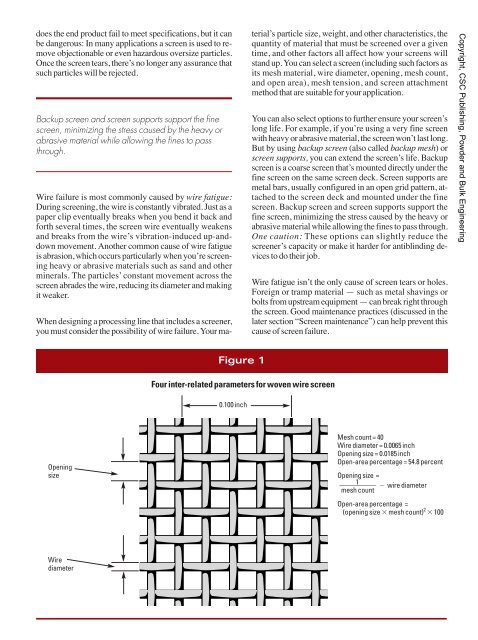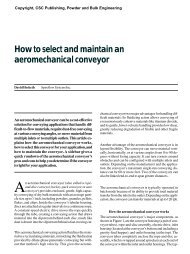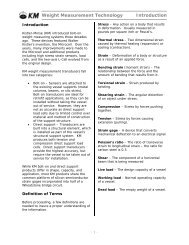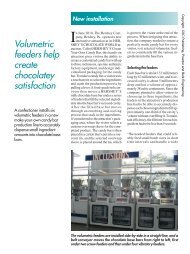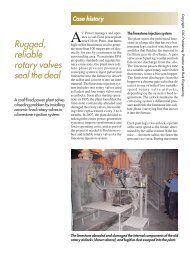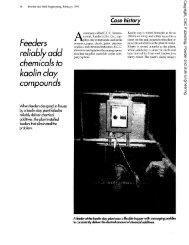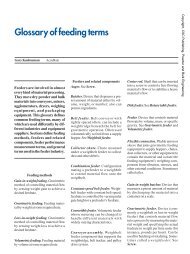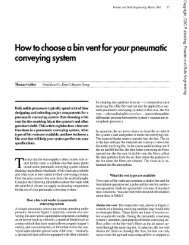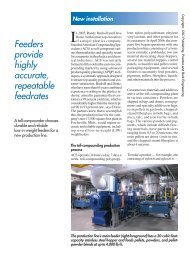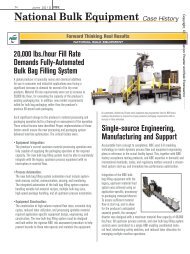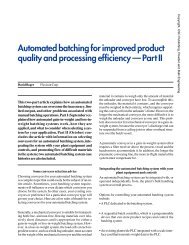Screener troubleshooting: Diagnosing and solving screen problems
Screener troubleshooting: Diagnosing and solving screen problems
Screener troubleshooting: Diagnosing and solving screen problems
Create successful ePaper yourself
Turn your PDF publications into a flip-book with our unique Google optimized e-Paper software.
does the end product fail to meet specifications, but it can<br />
be dangerous: In many applications a <strong>screen</strong> is used to remove<br />
objectionable or even hazardous oversize particles.<br />
Once the <strong>screen</strong> tears, there’s no longer any assurance that<br />
such particles will be rejected.<br />
Backup <strong>screen</strong> <strong>and</strong> <strong>screen</strong> supports support the fine<br />
<strong>screen</strong>, minimizing the stress caused by the heavy or<br />
abrasive material while allowing the fines to pass<br />
through.<br />
Wire failure is most commonly caused by wire fatigue:<br />
During <strong>screen</strong>ing, the wire is constantly vibrated. Just as a<br />
paper clip eventually breaks when you bend it back <strong>and</strong><br />
forth several times, the <strong>screen</strong> wire eventually weakens<br />
<strong>and</strong> breaks from the wire’s vibration-induced up-<strong>and</strong>down<br />
movement. Another common cause of wire fatigue<br />
is abrasion, which occurs particularly when you’re <strong>screen</strong>ing<br />
heavy or abrasive materials such as s<strong>and</strong> <strong>and</strong> other<br />
minerals. The particles’ constant movement across the<br />
<strong>screen</strong> abrades the wire, reducing its diameter <strong>and</strong> making<br />
it weaker.<br />
When designing a processing line that includes a <strong>screen</strong>er,<br />
you must consider the possibility of wire failure. Your material’s<br />
particle size, weight, <strong>and</strong> other characteristics, the<br />
quantity of material that must be <strong>screen</strong>ed over a given<br />
time, <strong>and</strong> other factors all affect how your <strong>screen</strong>s will<br />
st<strong>and</strong> up. You can select a <strong>screen</strong> (including such factors as<br />
its mesh material, wire diameter, opening, mesh count,<br />
<strong>and</strong> open area), mesh tension, <strong>and</strong> <strong>screen</strong> attachment<br />
method that are suitable for your application.<br />
You can also select options to further ensure your <strong>screen</strong>’s<br />
long life. For example, if you’re using a very fine <strong>screen</strong><br />
with heavy or abrasive material, the <strong>screen</strong> won’t last long.<br />
But by using backup <strong>screen</strong> (also called backup mesh) or<br />
<strong>screen</strong> supports, you can extend the <strong>screen</strong>’s life. Backup<br />
<strong>screen</strong> is a coarse <strong>screen</strong> that’s mounted directly under the<br />
fine <strong>screen</strong> on the same <strong>screen</strong> deck. Screen supports are<br />
metal bars, usually configured in an open grid pattern, attached<br />
to the <strong>screen</strong> deck <strong>and</strong> mounted under the fine<br />
<strong>screen</strong>. Backup <strong>screen</strong> <strong>and</strong> <strong>screen</strong> supports support the<br />
fine <strong>screen</strong>, minimizing the stress caused by the heavy or<br />
abrasive material while allowing the fines to pass through.<br />
One caution: These options can slightly reduce the<br />
<strong>screen</strong>er’s capacity or make it harder for antiblinding devices<br />
to do their job.<br />
Wire fatigue isn’t the only cause of <strong>screen</strong> tears or holes.<br />
Foreign or tramp material — such as metal shavings or<br />
bolts from upstream equipment — can break right through<br />
the <strong>screen</strong>. Good maintenance practices (discussed in the<br />
later section “Screen maintenance”) can help prevent this<br />
cause of <strong>screen</strong> failure.<br />
Copyright, CSC Publishing, Powder <strong>and</strong> Bulk Engineering<br />
Figure 1<br />
Four inter-related parameters for woven wire <strong>screen</strong><br />
0.100 inch<br />
Opening<br />
size<br />
Mesh count = 40<br />
Wire diameter = 0.0065 inch<br />
Opening size = 0.0185 inch<br />
Open-area percentage = 54.8 percent<br />
Opening size =<br />
—————<br />
1<br />
wire diameter<br />
mesh count<br />
Open-area percentage =<br />
(opening size mesh count) 2 100<br />
Wire<br />
diameter


